We were recently challenged by a customer to provide an economical cordless handset solution for their Skype for Business deployment. This same solution was required at each of their many small sites, so the economies of scale of a larger certified WiFi solution couldn’t be realised. There was no requirement for roaming as each of the sites is essentially autonomous, and this started us looking to stand-alone DECT solutions.
For the endpoint devices we chose the Yealink SIP DECT “W56P” base-station and DECT handset package. This pairing currently has a retail price of just over AUD200, so it ticked that box for the customer as well.
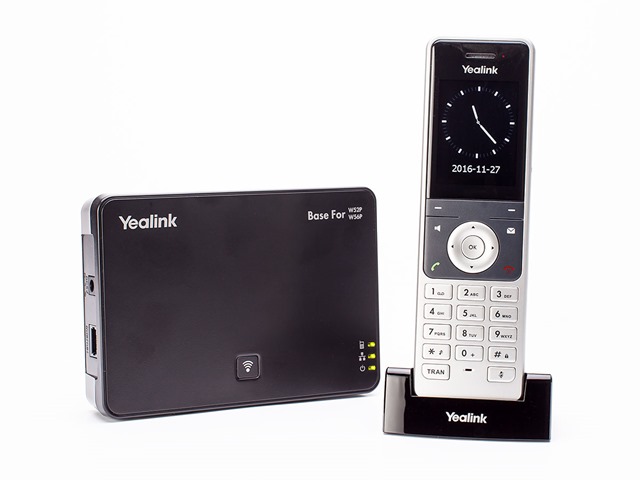 |
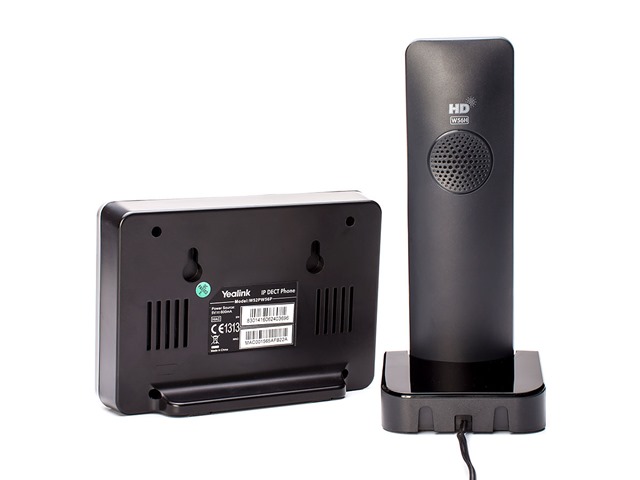 |
My unboxing experience was a pleasant one. The rather petite box manages to house:
- W52PW56P base station
- W56H SIP DECT handset
- Rechargeable battery
- W56H charging cradle (with ~1.7m / ~6′ figure-8 cable and USB plug)
- Belt clip
- Ethernet patch cable & 5V 600mA plugpack (for the base)
- Mains USB adapter to power the charging cradle (and free up a USB port on your PC)
- A helpful 10-page “Quick-Start Guide”
You can register up to 5 handsets to the one base, so if you want to expand on the above the purchase of the “W56H” SKU (~AUD150) includes just the phone components of handset, battery, charging cradle, belt clip & USB power adapter.
The DECT radio (base-station) can be powered by PoE so out in the real world you can locate these where-ever you can string a network cable. I fed mine in the greiginsydney lab via PoE, but of course if you don’t have that luxury (as in our customer’s smaller sites) the included plugpack is the way to go.
Both the DECT radio and charging base have rear-mounted keyhole slots for wall-mounting. The ‘foot’ out the back of the base (visible in the RH photo) will prevent the base sitting flat to the wall if you use the keyholes. Hopefully that won’t upset too many aesthetes – I presume it was a deliberate decision to ensure the ventilation slots have more chance of catching some passing airflow.
When flat on a desk and also when wall-mounted the handset sits in the charging base at a nice angle reclining away from you, reducing the risk of it falling out, even if hurriedly returned to the base. There’s a rim at the front that helps this too, as well as two circular locating studs that also contain the charging conductors. The cradle is essentially rectangular in shape (with some rounding of edges) so will make for an efficient layout if you wall-mount multiple units alongside each other.
Although not (yet?) available with SfB firmware, Yealink has been rapidly expanding their SfB product portfolio since becoming a certified handset vendor, and we have hopes that perhaps in the future we’ll see this family able to interface directly to SfB. For the time being however we’re registering these to the customer’s Sonus SBC 1000 gateway and hopping to SfB from there. More of that in another post coming soon.
The base defaults to DHCP to find an IP address, and it was simplicity itself to find it in my DHCP server:
PS C:\Users\greig> Get-DhcpServerv4Lease -scopeid 192.168.19.0 | ? {$_.Hostname -match "W52P"}
IPAddress ScopeId ClientId HostName AddressState LeaseExpiryTime
--------- ------- -------- -------- ------------ ---------------
192.168.19.180 192.168.19.0 00-15-65-af-b2-2a W52P.contoso.local Active 8/20/2017 8:06:19 PM
PS C:\Users\greig>
(BTW you’re able to customise the hostname it provides to DHCP from the default “W52P” on the General Information screen under Features).
From this point you can just browse to it: the default credentials are admin/admin. If you’ve seen any of the other Yealink peripherals for SfB the user-interface will be familiar to you:
Pairing the handsets with the base is a simple process and does not require PC access, which is great for staging before you ship the units to site. If you happen to be within range of the base you commence this by pressing and holding the button on the base for around 5 seconds – until the pairing LED (the top one on the right-hand edge) flashes slowly. Now from the handset it’s a matter of pressing the central ‘OK’ button to bring up the menu, then Settings / 6.Registration / Register Handset / <select the base from the list on-screen> / OK / <Pin:0000> / Done.
If your base station is mounted out of reach (or you’re driving this from off-site) the same process can be initiated from the “Handset&VoIP” menu on the Status tab by clicking the “Start Registration” button. That starts the base-station’s LED flashing as above and the pairing process from the handset is as before:
From this point the registration process with your SIP host is much the same as any other SIP peripheral. I’ll screen-grab that and walk you through it in a following post, but if you’re in a hurry just browse to the Account / Register tab to set the phone’s credentials and the SIP Server host, protocol and port settings:
In operation I found it a really nice handset to use. The buttons are large and give great tactile feedback, with the screen responding promptly to key-presses. I couldn’t fault the audio quality (testing as I was using G.711a). Range is a hard one to test, but I went for a wander out in the street here in suburban Sydney outside the double-brick Greiginsydney fortress and made it almost 50m (164’) before the audio started to go a bit choppy. It’s performance within the building was flawless.
Other observations & features:
- nice to see G.722 amongst the codecs on offer, adding to PCMU, PCMA, G.729, G.726-32 and two G.723 options
- inbuilt “shared line appearance”, so multiple handsets can make or receive calls on the same line
- the handset has a colour display
- the handset has an iPhone-compatible headset socket in the bottom of it (although unfortunately I couldn’t get it to respond to the answer/hangup button)
- the handset has an inbuilt call history. View all calls or choose from the menu to see only those placed, missed or received
- the base station supports IPv6
- you can import a CSV or XML directory file to the phone itself, or integrate with LDAP/LDAPs. LDAP lookup can be enabled for incoming as well as outgoing calls
- QoS is supported. You can specify the ports it’s to use for RTP & it allows separate DSCP values for signalling and media
- automatic daylight saving time support is inbuilt – just tell it where you are and it handles the specifics automatically:
- ditto for tones – it has the standards in-built, or you can DIY to suit:
- you’re going to misplace the phone at some stage (if it’s not a daily occurrence), and to help find it you can page it from the browser. (See the earlier “Registration” image)
Bad points / gripes:
- no ring-tone to the headset when you have one plugged in. The only ringing sound is from the handset itself, so you might miss a call in a loud environment if you’re wearing the phone on your belt (and maybe using the headset as earplugs)
- unable to answer/end a call using the headset’s inline button
- no “smart” / T9 text search of the LDAP or inbuilt contact directories. (That would have been a nice to have)
- it turns out some clown made a mistake in his LDAP setup and there’s no “test” button or other way of confirming the setup is good, so some time was wasted in debugging that. That would be a nice add in a future firmware update
- it’s a tiny one and probably not going to get in the way normally, but there seems a remarkably short timeout on the browser interface & I found myself forever having to re-auth to it. I looked but couldn’t find a way of extending that. (It expires the session after something like 5 – 10 minutes of inactivity)
Summary
I found the W56H a really nice portable handset. The look, feel, sound and operation were excellent. It’s packed full of features that make it very flexible, and yet the price is remarkably economical. You could probably register the base-station directly to SfB as though it’s a PSTN gateway, although for official support you’d need to tandem through a supported gateway like one from the AudioCodes or Sonus families. That’s the subject for another post, coming soon…
The review unit was supplied by Yealink Australia, and as always the photos are by my in-house photographer and partner Rocky.
Revision History
27th August 2017. This is the initial release.
– G.
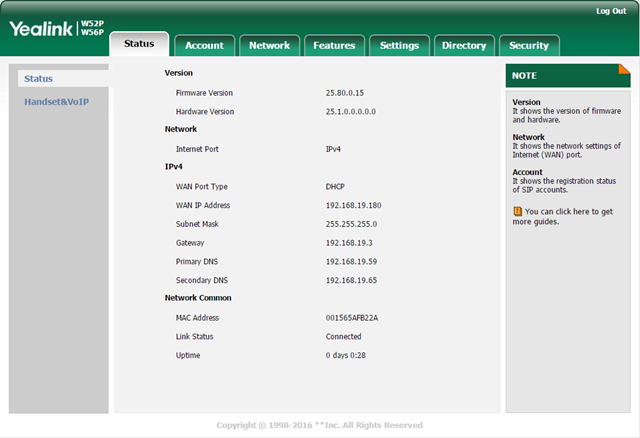

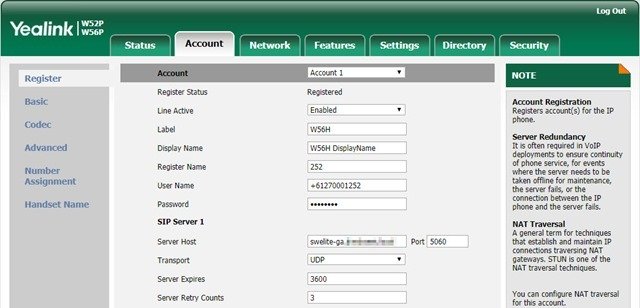
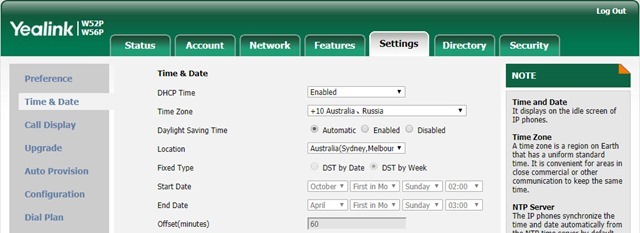





sounds interersting, if they offer a Skype for Business/SFBo Aware Firmware for that base unit.
But Keep in mind. It is still a “single Location base” and you cannot cover a building with multiple base stations. Thats still the market für Ascom, Spectralink and others with a “Controller” and decentralized DECT antennas.
As always, thanks for the info! This does look like a very simple and not too expensive DECT solution.
Neat
Is it capable of receiving or sending SIP SIMPLE messages?
Can the MWI be distinguished when each handset has multiple SIP extensions?
Is TCP TLS painful to configure? (Fun with ssh)
.. for sRTP?
OpenVPN client baked in? Web ui configurable?
I will be replacing gigaset dect ip to avoid unresolved firmware woes.
Is there a multicell option? One handset roaming between basestations.